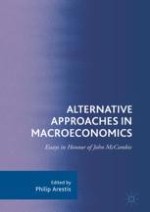2018 | OriginalPaper | Buchkapitel
12. Production Functions, the Kaldor-Verdoorn Law and Methodology
verfasst von : Marc Lavoie
Erschienen in: Alternative Approaches in Macroeconomics
Aktivieren Sie unsere intelligente Suche, um passende Fachinhalte oder Patente zu finden.
Wählen Sie Textabschnitte aus um mit Künstlicher Intelligenz passenden Patente zu finden. powered by
Markieren Sie Textabschnitte, um KI-gestützt weitere passende Inhalte zu finden. powered by
